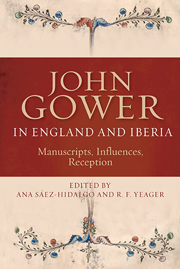Book contents
- Frontmatter
- Contents
- List of Illustrations
- Abbreviations
- Introduction
- I Manuscripts
- II Iberia
- III The Classical Tradition
- IV Economy
- 12 Goods and the Good in the Confessio Amantis
- 13 Gower's Kiste
- 14 John Gower: Balzac of the Fourteenth Century
- 15 Gower's Gifts
- V Reception
- Notes on Contributors
- Bibliography
- Index
15 - Gower's Gifts
from IV - Economy
Published online by Cambridge University Press: 05 August 2014
- Frontmatter
- Contents
- List of Illustrations
- Abbreviations
- Introduction
- I Manuscripts
- II Iberia
- III The Classical Tradition
- IV Economy
- 12 Goods and the Good in the Confessio Amantis
- 13 Gower's Kiste
- 14 John Gower: Balzac of the Fourteenth Century
- 15 Gower's Gifts
- V Reception
- Notes on Contributors
- Bibliography
- Index
Summary
Everyone is familiar with gifts and their various functions. Gifts cement our relationships, reward employees, and even arouse our competitive instincts and charitable impulses. Gifts routinely cross social boundaries, such as that between the personal and professional. Many readers of this collection will at some point have received a gift from a family member meant for the recipient's professional life, for example, which would evoke a variety of emotional responses: love, gratitude for the gift's generosity, awkwardness if the family member misunderstood the recipient's professional needs, or even amusement over the gift's appropriateness or inappropriateness. Their emotional impact aside, however, gifts remain forms of exchange, and thus economic in nature. When an academic department buys a gift for a clerical worker, for example, that gift might supplement that worker's meager compensation, at the same time that it reinforces her or his subordinate status, all while conveying esteem or disdain depending on the gift and the manner of its giving. I raise these contemporary examples as a way of suggesting why modern readers may not notice gifts when they come up in John Gower's Confessio Amantis: they are so quotidian a part of our own experience that we do not think of them in economic terms any more than we might interrogate our own birthday gifts or colorful conference tote bags. It does not help that Gower does not focus stories around gifts as such; some of the gifts in the Confessio are important to the stories' plots, like the “cloth of gold […] mantel” (CA V.4201) Medea sent to Creusa, or King Alphonse’s gift of “an erldom” (CA I.3354) to Danz Petro in “Humility and the Tale of Three Questions,” but even the “Tale of Constantine and Sylvester” does not spend much space on the “venym” (CA II.3490) of that most generous gift of the Donation of Constantine.
- Type
- Chapter
- Information
- John Gower in England and IberiaManuscripts, Influences, Reception, pp. 229 - 242Publisher: Boydell & BrewerPrint publication year: 2014

